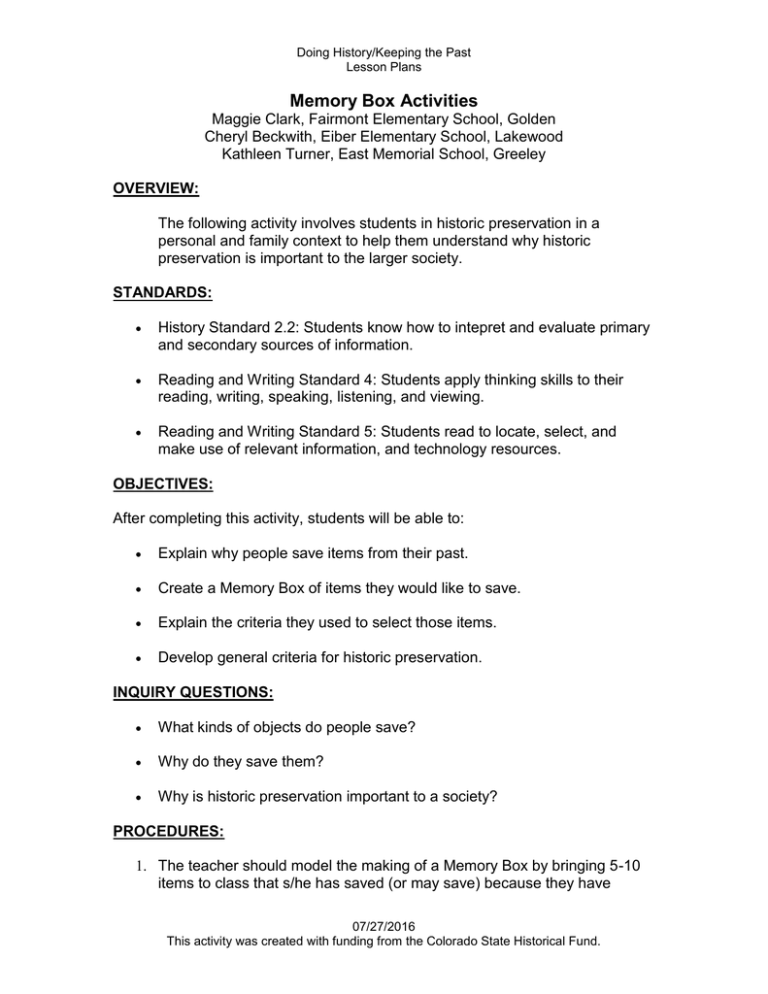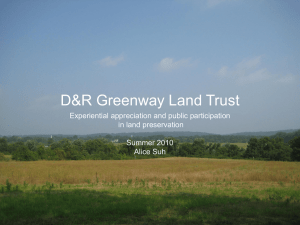Memory Box Activities
advertisement

Doing History/Keeping the Past Lesson Plans Memory Box Activities Maggie Clark, Fairmont Elementary School, Golden Cheryl Beckwith, Eiber Elementary School, Lakewood Kathleen Turner, East Memorial School, Greeley OVERVIEW: The following activity involves students in historic preservation in a personal and family context to help them understand why historic preservation is important to the larger society. STANDARDS: History Standard 2.2: Students know how to intepret and evaluate primary and secondary sources of information. Reading and Writing Standard 4: Students apply thinking skills to their reading, writing, speaking, listening, and viewing. Reading and Writing Standard 5: Students read to locate, select, and make use of relevant information, and technology resources. OBJECTIVES: After completing this activity, students will be able to: Explain why people save items from their past. Create a Memory Box of items they would like to save. Explain the criteria they used to select those items. Develop general criteria for historic preservation. INQUIRY QUESTIONS: What kinds of objects do people save? Why do they save them? Why is historic preservation important to a society? PROCEDURES: 1. The teacher should model the making of a Memory Box by bringing 5-10 items to class that s/he has saved (or may save) because they have 07/27/2016 This activity was created with funding from the Colorado State Historical Fund. Doing History/Keeping the Past Lesson Plans personal or family value (“To Preserve or Not to Preserve: A Look Back” for this phase of the activity). 2. Use these items to generate a discussion about the meaning and value of personal or family objects. 3. Assign an out-of-class activity in which the students interview two adults (parents, relatives, family friends) about what items they have or wish they had saved and why. Reproduce copies of the "To Preserve or Not to Preserve Data Sheet" . Also see the "Dear Parents" letter (see both handouts below). 4. Discuss the findings from the students' data sheets. Find out what items and explanations the sheets have in common. Are there predictable criteria for people saving memorabilia? (See “To Preserve or Not to Preserve: Establishing Criteria” for this phase of the activity.) 5. Have students develop their own 5-10 item Memory Box (See “To Preserve or Not to Preserve: Creating Your Own Memory Box” for this phase of the activity). 6. Ask students to revisit and revise the criteria that helps to explain why people find value in historical artifacts and why historic preservation is valuable. EXTENSIONS: 1. Make a Memory Box for the 1950's, 1960's, 1970's, 1980's or 1990's. 2. You are a museum curator. Your assignment is to make a Memory Box for: o A miner. o A farmer. o A one-room school from the 1880's. 3. Make a class Memory Box for the school year. Let students save items they think should be included in the box. Accept all items including newspaper articles to mark important events. Select a class historian to check the contents of the Box on a monthly basis, using the criteria matrix developed for this activity. Continue the process until the end of the year. At the end of the year, do a final sort, keeping only 10 items. Save and deliver to their next year's teacher. 4. Invite a guest speaker from the Historical Society. 07/27/2016 This activity was created with funding from the Colorado State Historical Fund. Doing History/Keeping the Past Lesson Plans To Preserve or Not to Preserve: A Look Back Maggie Clark, Fairmont Elementary School, Golden Cheryl Beckwith, Eiber Elementary School, Lakewood Kathleen Turner, East Memorial School, Greeley OVERVIEW: In this historic preservation activity, students will begin to analyze what criteria are used to select items to preserve. OBJECTIVES: After completing this activity, students will be able to: Observe as their teacher shares items from his/her own Memory Box. Observe, identify, and discuss items from Great Grandmother's trunk. Compare and contrast items from Great Grandmother's trunk and the teacher's Memory Box. Discuss criteria for saving items (e.g., a special memory, time, person, place, or achievement; sentimental or collectable value). INQUIRY QUESTIONS: What objects or artifacts are important to people? Why are these objects and artifacts important to these people? How are Great Grandmother's trunk and the teacher's Memory Box similar and different? PROCEDURES: 1. Teacher will put together his or her own Memory Box to share and model for students. 2. Teacher will share and explain reasons why the items were chosen for saving. 3. Students explore and discuss items in Great Grandmother's trunk. 07/27/2016 This activity was created with funding from the Colorado State Historical Fund. Doing History/Keeping the Past Lesson Plans 4. Students should explore reasons for why the items in both were selected. 5. Using a Venn Diagram, the similarities and differences should be charted. 6. Discuss what the children might have learned about the owners of the trunk/box through analysis of the items. 7. NOTE: Great Grandmother's trunks are often available from the local historical society; of the teacher can create his or her own. 07/27/2016 This activity was created with funding from the Colorado State Historical Fund. Doing History/Keeping the Past Lesson Plans To Preserve or Not to Preserve: Establishing Criteria Maggie Clark, Fairmont Elementary School, Golden Cheryl Beckwith, Eiber Elementary School, Lakewood Kathleen Turner, East Memorial School, Greeley OVERVIEW: Students will collect data and establish the criteria used to determine why an object or artifact is worth preserving. OBJECTIVES: After completing this activity, students will be able to: Collect data for a purpose. Analyze the data collected to generate a list of common characteristics of items that are preserved. Identify common characteristics for preservation. Establish criteria for preservation. INQUIRY QUESTIONS: What objects or artifacts are important to people? Why are these objects and artifacts important to these people? PROCEDURES: 1. As homework, students are to interview two adults using the "To Preserve or Not to Preserve Data Sheet" to record the adults' responses (see handouts below). 2. After the data is collected by students, the class will be divided into small groups. Each group will select a recorder and a reporter. 3. Students working in small groups will share and record their data. 4. Students will select five of the most frequently mentioned reasons for preservation. 07/27/2016 This activity was created with funding from the Colorado State Historical Fund. Doing History/Keeping the Past Lesson Plans 5. Each group will report their findings to the whole class. 6. Data will be recorded on a chart and tabulated. 7. The five most frequently used reasons for preservation will be established as criteria for the selection of items that the students will include in their own Memory Boxes. 07/27/2016 This activity was created with funding from the Colorado State Historical Fund. Doing History/Keeping the Past Lesson Plans To Preserve or Not to Preserve Data Sheet Name: _____________________________ Date: __________________ Interview two adults (parents, relatives, family friends, neighbors) to find out what items they would include in a Memory Box. List the items below and write the reason they would save them. Item Reason 07/27/2016 This activity was created with funding from the Colorado State Historical Fund. Doing History/Keeping the Past Lesson Plans Dear Parents: As we continue our study of Colorado History, we are learning about the importance of historic preservation. We have been working in the classroom to establish reasons used to select items that are preserved. Your child has been asked to interview two adults and fill out the attached data collection sheet that lists the ten items each adult would include in a “Memory Box”, along with the reasons they would preserve or save each item. Items selected might include pictures, toys, books, and sports memorabilia. Thanks you for helping us with this preservation activity. Please call if you have questions. Sincerely, 07/27/2016 This activity was created with funding from the Colorado State Historical Fund. Doing History/Keeping the Past Lesson Plans To Preserve or Not to Preserve: Creating Your Own Memory Box Maggie Clark, Fairmont Elementary School, Golden Cheryl Beckwith, Eiber Elementary School, Lakewood Kathleen Turner, East Memorial School, Greeley OVERVIEW: Students will use the criteria they have established to create their own Memory Box. OBJECTIVES: After completing this activity, students will be able to: Fill out the Memory Box Matrix, analyze the data, and based on their findings will create their own Memory Boxes. Share their Memory Boxes with large group and tell which of the criteria were used to select each item INQUIRY QUESTIONS: What objects or artifacts are important to people? Why are these objects and artifacts important to these people? PROCEDURES: 1. Students will brainstorm a list of 15-25 items they might like to include in their Memory Boxes. 2. Students will prioritize their lists and select the top 14 items they want to include on the Memory Box Matrix (see handout below). 3. Students will write selected items on the Matrix and then use plusses and minuses to prioritize the items. 4. Students will then analyze their matrix to determine the top 10 items that will be included in their Memory Boxes. 5. Each student will compile their Memory Box and share them with the class. 07/27/2016 This activity was created with funding from the Colorado State Historical Fund. Doing History/Keeping the Past Lesson Plans To Preserve or Not to Preserve Matrix for Memory Box Name: __________________________ Criterion 1 Criterion 2 Criterion 3 Criterion 4 Criterion 5 Items 07/27/2016 This activity was created with funding from the Colorado State Historical Fund.

